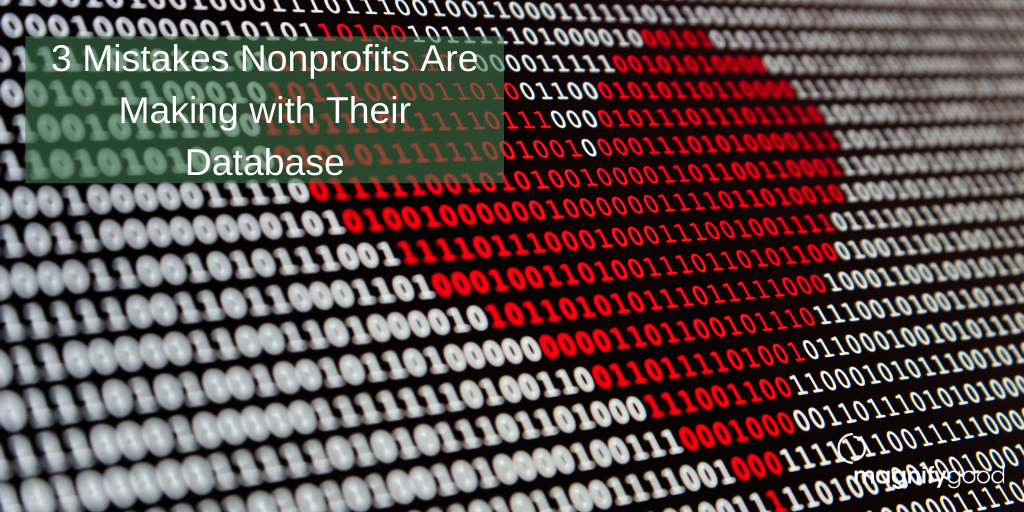Whether they know it or not, nonprofit organizations are surrounded by data that can be extremely useful and effective in their efforts to raise more money and generate impact. From fundraising and marketing, to programs and services, data can be used to analyze organizational impact, donor relationship and campaign performance.
Your nonprofit’s database can be a goldmine of information that can help you create stronger, more meaningful connections with your supporters. If you’re not tapping into all of that potential, don’t worry you’re not alone.
In a recent study that surveyed more than 460 nonprofit professionals, roughly 90 percent of respondents reported that their organizations are collecting data, but only 40 percent say they’re using this data to regularly make decisions about their communication or operations.
If you’re ready to take your efforts to the next level using all of the data your organization has collected throughout the years, we can help. Here are three mistakes nonprofits make when it comes to their databases, and how you can fix them.
Not Segmenting Your Database
Your donor development team is equipped with a database like Raiser’s Edge to manage donor data. But what exactly is going into it? Have you defined the key information you want to capture in your database, along with a deliberate update system to ensure your contacts are saved thoroughly and accurately? Do you have multiple lists of contacts living in different places in your database with duplicate or stale information? Is your development team’s database integrated in a way that allows both your donor development and communications teams to share and benefit from this valuable information?
Beyond simply importing your lists, you’ll want to segment your database to truly drive stronger connections with your donors. One of the most influential functions of online databases with marketing automation software solutions and CRM tools is the ability to segment your contact list. Segmenting prospects as they begin making connections with your organization — such as downloading gated content pieces or visiting specific pages on your website — presents an opportunity to continue reaching them with content they’re interested in through email marketing campaigns.
Not Using Data to Personalize Outreach
Donors increasingly expect to receive personalized communications from the nonprofits they engage with, and that means more than just being addressed by name in an automated email. This is where utilizing that valuable data you’ve collected comes into play.
Imagine you’re a nonprofit focused on alleviating hunger, and an individual in your database has repeatedly visited your page promoting volunteer opportunities. You can enter them into an automated email campaign promoting numerous volunteer opportunities for contacts who’ve demonstrated an interest in them. Each of your supporters has diversely invested support or interest in your mission. Using the data gathered by your marketing automation platform, you can effectively bridge a meaningful connection between them and your organization with content geared directly to them that’s delivered when and how they want it.
Using Separate Databases for Marketing and Development
For most nonprofit organizations, Marketing and Development teams traditionally work in silos. Donor development teams use a database to track prospects, their potential level of giving and other donor-related details, while marketing teams are keeping a separate database of contacts to communicate with. When these databases aren’t integrated, the donor development teams are missing out on valuable information about prospects, which can be used to attract support.
The lack of integration between the two sides of the organization can cause frustration internally — or worse — with your donors. Using the same database will simplify tasks and prevent donors from feeling overwhelmed by too many competing messages during the same time period. When both teams are working in silos, activities can cancel each other out, dissuading donor engagement.
Getting these teams together generates tremendous results in terms of retaining and attracting more donors — ultimately raising more funds to support your mission. When both teams are working together and using the same database, your organization can ensure that its current and prospective donors are receiving personalized messages and content, driving a deeper connection between them and your cause.
Using Data for Stronger Outcomes
With the digital landscape leveling the playing field for organizations seeking to attract and engage new donors, how do you ensure yours cuts through the noise? There’s no doubt that using data creates stronger outcomes. If nonprofits truly want to transform their impact in the digital landscape, they must embrace data and the tools that analyze it.
If you’re ready to get started, but aren’t sure where to begin, give us a call. You can schedule a time talk here.
Photo Credit: Alexander Sinn via Unsplash



